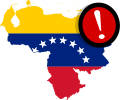
Back التضخم المفرط في فنزويلا Arabic Hiperinflación en Venezuela Spanish Hyperinflation au Venezuela French Hiperinflasi di Venezuela ID 베네수엘라의 초인플레이션 Korean Venezuela ê chhiau-phòng-tiòng ZH-MIN-NAN
| Part of the crisis in Venezuela | |
 Venezuelan migrants in Bogotá selling crafts made of worthless Venezuelan banknotes in November 2019 | |
| Date | 2016–early 2022 |
|---|---|
| Location | |
| Cause | Government policies, price controls, corruption, currency devaluations, heavy money-printing, and deficit government spending |
| Outcome | Large decline in real wages despite continuous nominal wage increases,[1] unemployment, rising prices in goods, redenomination of the Venezuelan bolívar fuerte to the bolívar soberano and then again to the bolívar digital, dollarization,[2] decrease of tax revenues and shortages of foreign currency reserves and goods |
Hyperinflation in Venezuela was the currency instability in Venezuela that began in 2016 during the country's ongoing socioeconomic and political crisis.[3] Venezuela began experiencing continuous and uninterrupted inflation in 1983, with double-digit annual inflation rates. Inflation rates became the highest in the world by 2014 under Nicolás Maduro, and continued to increase in the following years, with inflation exceeding 1,000,000% by 2018. In comparison to previous hyperinflationary episodes, the ongoing hyperinflation crisis is more severe than those of Argentina, Bolivia, Brazil, Nicaragua, and Peru in the 1980s and 1990s, and that of Zimbabwe in the late-2000s.
In 2014, the annual inflation rate reached 69%,[4] the highest in the world.[5][6] In 2015, the inflation rate was 181%, again the highest in the world and the highest in the country's history at the time.[7][8] The rate reached 800% in 2016,[9] over 4,000% in 2017,[10][11][12][13] and about 1,700,000% in 2018,[14] and reaching 2,000,000%, with Venezuela spiraling into hyperinflation.[15] While the Venezuelan government "had essentially stopped" producing official inflation estimates as of early 2018, inflation economist Steve Hanke estimated the rate at that time to be 5,220%.[16] The Central Bank of Venezuela (BCV) officially estimates that the inflation rate increased to 53,798,500% between 2016 and April 2019.[17] In April 2019, the International Monetary Fund estimated that inflation would reach 10,000,000% by the end of 2019.[18] Several economic controls were lifted by Maduro administration in 2019, which helped to partially tame inflation until May 2020.[19]
In December 2021, economists and the Central Bank of Venezuela announced that in the first quarter of 2022, Venezuela would reach more than 12 months with monthly inflation below 50% after more than four years of a hyperinflationary cycle. This would technically indicate its exit from hyperinflation, but the consequences would remain.[20][21]
| Crisis in Venezuela |
|---|
 |
|
|
- ^ "The reality of wages in Venezuela". 25 June 2021.
- ^ "How Venezuela Became One Big Casino". The Atlantic. 4 January 2022.
- ^ Hanke, Steve (18 August 2018). "Venezuela's Great Bolivar Scam, Nothing but a Face Lift". Forbes. Archived from the original on 19 August 2018. Retrieved 19 August 2018.
- ^ "Venezuela 2014 inflation hits 68.5 pct -central bank". Archived from the original on 9 May 2019. Retrieved 7 June 2019.
- ^ "Venezuela annual inflation 180 percent". Reuters. 1 October 2015. Archived from the original on 27 October 2017. Retrieved 15 November 2017.
- ^ "The Three Countries with the Highest Inflation". Archived from the original on 24 February 2019. Retrieved 7 June 2019.
- ^ Cristóbal Nagel, Juan (13 July 2015). "Looking into the Black Box of Venezuela's Economy". Foreign Policy. Archived from the original on 14 July 2015. Retrieved 14 July 2015.
- ^ "Venezuela annual inflation 180 percent: opposition newspaper". Archived from the original on 8 December 2018. Retrieved 7 June 2019.
- ^ Venezuela country profile (Economy tab), Archived 2019-08-04 at the Wayback Machine World in Figures. Copyright © The Economist Newspaper Limited 2017. (Retrieved 14 June 2017.)
- ^ Sequera, Vivian (21 February 2018). "Venezuelans report big weight losses in 2017 as hunger hits". Reuters. Archived from the original on 22 February 2018. Retrieved 23 February 2018.
- ^ Corina, Pons (20 January 2017). "Venezuela 2016 inflation hits 800 percent, GDP shrinks 19 percent: document". Reuters. Archived from the original on 15 November 2017. Retrieved 15 November 2017.
- ^ "AssetMacro". Archived from the original on 16 February 2017. Retrieved 15 February 2017.
- ^ Davies, Wyre (20 February 2016). "Venezuela's decline fuelled by plunging oil prices". BBC News, Latin America. Archived from the original on 21 February 2016. Retrieved 20 February 2016.
- ^ "Inflación de 2018 cerró en 1.698.488%, según la Asamblea Nacional" (in Spanish). Efecto Cocuyo. 9 January 2019. Archived from the original on 10 January 2019. Retrieved 9 January 2019.
- ^ Herrero, Ana Vanessa; Malkin, Elisabeth (16 January 2017). "Venezuela Issues New Bank Notes Because of Hyperinflation". The New York Times. Archived from the original on 31 July 2017. Retrieved 17 January 2017.
- ^ Krauze, Enrique (8 March 2018). "Hell of a Fiesta". New York Review of Books. Archived from the original on 22 February 2018. Retrieved 1 March 2018.
- ^ "BCV admits hyperinflation of 53,798,500% since 2016". Venezuela Al Dia (in Spanish). 28 May 2019. Archived from the original on 29 May 2019. Retrieved 5 June 2019.
- ^ "International Monetary Fund". Archived from the original on 29 May 2019. Retrieved 7 June 2019.
- ^ "Venezuela's timid gains in taming inflation fade as food prices soar". Reuters. 11 May 2020.
- ^ Singer, Florantonia (22 December 2021). "Venezuela está cerca de dejar atrás la hiperinflación, pero no sus secuelas". El País (in Spanish). Retrieved 25 August 2022.
- ^ "Venezuela creeps out of hyperinflation, but no one feels it". France24. 15 January 2022. Retrieved 28 August 2022.